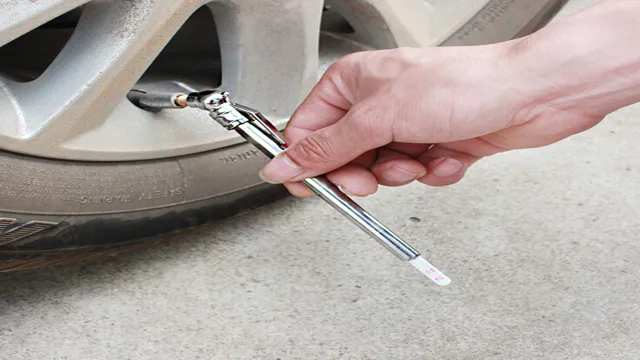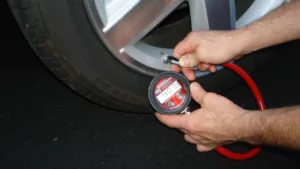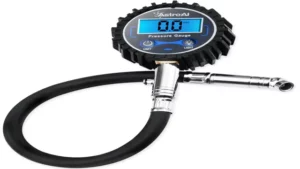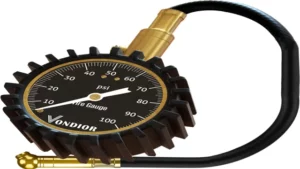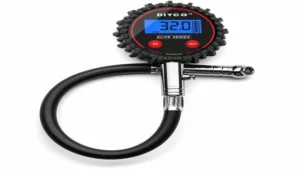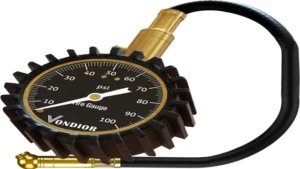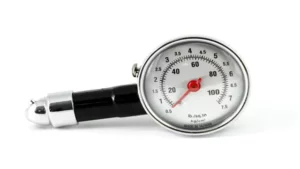Do you own a vehicle? Do you know how important it is to keep the tires properly inflated? It is essential to maintain the right tire pressure because it not only ensures a smooth ride but also improves fuel efficiency and reduces the risk of accidents. A tire pressure gauge is a simple tool that helps you keep track of the tire pressure, but do you know how to use it correctly? In this blog, we will guide you on how to use a tire pressure gauge and share some tips on maintaining tire pressure. So, let’s dive in and learn everything about tire pressure!
Gather Necessary Materials
If you’re wondering how to use a tire pressure gauge, the first step is to gather the necessary materials. You’ll need a tire pressure gauge, which can be bought at most hardware or auto stores, as well as an air compressor or tire pump. Before using the gauge, it’s important to familiarize yourself with it.
Most gauges have a hose or stem that inserts into the tire valve, and a gauge that displays the tire pressure reading. Some gauges may also have a reset button or a bleeder valve to release excess air. Once you have everything you need, make sure the tires are cool and there is no debris around the valve stem.
Insert the gauge into the valve stem and press down firmly until you hear a hiss of air. Check the gauge reading and compare it to the recommended tire pressure for your vehicle, which can typically be found in the owner’s manual or on a sticker inside the driver’s door. If the pressure is too low, use the air compressor or pump to fill the tire to the correct level.
Using a tire pressure gauge may seem daunting at first, but with a little practice, it will become second nature.
Tire Pressure Gauge
When it comes to checking the tire pressure in your car, having a reliable tire pressure gauge is essential. Before you begin, gather the necessary materials to ensure that you can get an accurate reading. The first thing you’ll need is a tire pressure gauge.
There are plenty of options to choose from, including digital and analog gauges. You’ll also need to ensure that your car is parked on a stable, level surface. This will help prevent any errors in your reading due to uneven weight distribution.
Additionally, if you haven’t checked your tires in a while, consider investing in an air compressor. This will allow you to add air to your tires quickly and easily if you find that they are underinflated. By having these materials on hand, you’ll be able to check your tire pressure efficiently and ensure that your car is safe to drive.
So, go ahead and gather your tire pressure gauge, find a stable surface, and get ready to check those tires!
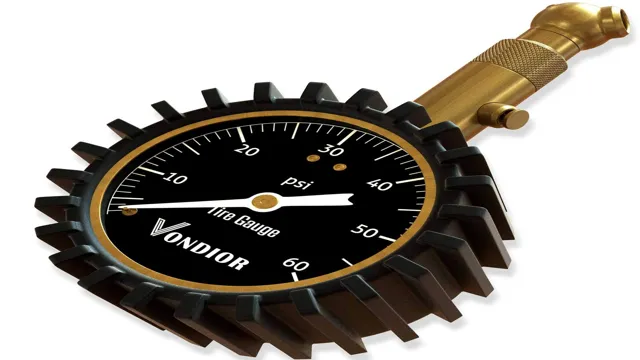
Prepare Your Vehicle
If you’re not familiar with how to use a tire pressure gauge, don’t worry, it’s not as complicated as it sounds. First, make sure the gauge you have matches your tire’s pressure range. Next, remove the cap from the tire valve and press the gauge onto the valve stem firmly.
The gauge should produce a reading that shows the current tire pressure. If the pressure is too low, use an air compressor to add air to the tire. If it is too high, release air slowly by pressing on the metal pin in the center of the valve stem until the desired pressure is reached.
Remember to check your tire pressure regularly to ensure optimal tire performance, fuel efficiency, and overall safety while driving.
Park on Level Ground
When parking your vehicle, it is important to choose a level surface to prevent any accidental rolling or movement. Parking on an inclined or sloping surface can cause your vehicle to roll away, leading to a potential safety hazard. Furthermore, parking on an inclined surface can cause strain on your vehicle’s transmission and brakes, leading to undue wear and tear.
So, it’s better to find a flat surface for your vehicle to rest on. Moreover, leveling your car’s tires by placing wheel chocks underneath the wheels is a wise precaution to take to prevent your car from rolling away. Remember, a little effort in finding level ground for parking can go a long way in keeping your vehicle safe and sound.
Locate Tire Pressure Recommendations
One important step in preparing your vehicle for safe travels is by checking and maintaining the correct tire pressure as recommended by the manufacturer. It is essential to know the right tire pressure for your car, as incorrect inflation can lead to several problems such as reduced fuel efficiency, tire damage, and even accidents. To locate your vehicle’s tire pressure recommendations, first, check your owner’s manual, which usually contains the standard tire pressure ranges.
Alternatively, look for a label located on the driver’s side doorjamb, the glove compartment, or the fuel door. This label shows the recommended tire pressure for your front and rear tires. Keep in mind that tire pressure should be regularly checked and adjusted based on driving conditions and time of year: colder temperatures can cause tire pressure to drop quicker.
Maintaining proper tire pressure will help ensure a smoother ride, increase fuel efficiency, and promote longer tire life.
Check Tire Pressure
If you want to make sure that you’re getting optimal performance and mileage out of your vehicle, checking your tire pressure is a must. But if you’re new to using a tire pressure gauge, it might seem a little intimidating at first. Here’s how to do it: First, you’ll need to find out the recommended pressure for your specific make and model.
Once you have that information, unscrew the cap on the tire valve and press the gauge onto the valve stem. You should hear a hissing sound as the gauge takes a measurement. The gauge will show you the psi (pounds per square inch) reading, which you can then compare to the recommended pressure.
If it’s too low, use an air compressor to add air until you reach the recommended level. If it’s too high, use the gauge to release some air until you reach the correct pressure. And that’s it! By regularly checking your tire pressure, you can help ensure your vehicle is performing at its best and even extend the life of your tires.
Remove Valve Cap
Checking the tire pressure is an essential maintenance task that every vehicle owner should undertake periodically. One crucial step in this process is to remove the valve cap. The valve cap is the small, plastic cap on the end of the tire valve.
It serves two purposes; to keep dirt and dust out of the valve and to prevent any loss of air. However, before checking the tire pressure, ensure that the valve cap is removed from the tire valve. It is a small but essential step that could affect the accuracy of the pressure reading.
The valve cap can be easily removed by unscrewing it counterclockwise. Ensure that you keep the valve cap safe and return it to the valve once you have checked the tire pressure. Neglecting to do so can lead to the accumulation of dirt and dust particles on the tire valve, which could cause it to leak air slowly.
So, remember to remove the valve cap to ensure you get an accurate tire pressure reading.
Press Gauge Onto Valve Stem
Checking your tire pressure regularly is critical for a safer and smoother driving experience. It’s essential to make sure that your tires have the optimal pressure to improve fuel efficiency, extend tire life, and prevent accidents. The first step is to press the gauge onto the valve stem of your tire, ensuring the gauge is firmly against the valve stem, so you get an accurate reading.
As you press down on the gauge, you may hear a hissing sound indicating the air pressure coming through the valve. The gauge will display the tire pressure reading in PSI or bar, depending on the type of gauge. If the pressure is within the recommended range, you’re good to go.
If it is too low, you need to inflate your tires to the recommended pressure. Be sure to check your tires regularly to keep them in good condition and drive safely. Remember, regular tire checks can save you from bigger issues down the road, such as blowouts or punctures, making you a safer driver.
Read Pressure Display
One of the most critical aspects of tire maintenance is ensuring that your tires are properly inflated. If your tires are underinflated, they can wear out faster, negatively impact your vehicle’s fuel economy, and even compromise your safety on the road. Thankfully, checking your tire pressure is a simple task that can be easily done at home or at a gas station.
All you need to do is locate your tire’s recommended pressure, which can usually be found on a sticker inside the driver’s side door or in your owner’s manual. Then, use a tire pressure gauge to measure your tire’s current pressure and compare it to the recommended pressure. If you notice that your tire pressure is too low, use an air pump to fill your tires to the proper level.
By routinely checking your tire pressure, you can avoid costly and dangerous tire-related issues down the road.
Adjust Tire Pressure if Necessary
To use a tire pressure gauge, you first need to locate your vehicle’s recommended tire pressure. This information can be found in your owner’s manual, on the driver’s side door jamb, or even on the tire itself. Once you know the recommended pressure, you can then use the tire pressure gauge to check the pressure of each tire.
Simply unscrew the valve cap and press the gauge onto the valve stem until you hear a hiss of air. The gauge will give you a reading of the pressure in pounds per square inch (PSI). If the pressure is too low, use an air compressor to fill the tire to the recommended pressure.
On the other hand, if the pressure is too high, you can use the gauge to release air until the pressure is correct. It’s important to keep your tires at the recommended pressure for optimal performance and safety on the road. Adjusting tire pressure may seem like a small task, but it can make a big difference in your driving experience, so be sure to check your tire pressure regularly.
Add Air or Release Air
Adjusting tire pressure is an essential part of vehicle maintenance that can help improve your driving experience and prolong the life of your tires. Did you know that the recommended tire pressure can vary depending on your vehicle type and driving conditions? Low tire pressure can cause uneven tire wear and decreased fuel efficiency, while over-inflated tires can lead to a rougher ride and increased risk of a blowout. To ensure optimal performance, it’s recommended to check your tire pressure at least once a month and adjust it if necessary.
If your tire pressure is low, add air until it reaches the recommended pressure indicated in your owner’s manual or on the tire sidewall. On the other hand, if your tire pressure is too high, release air until it reaches the recommended pressure. Make sure to use a reliable tire pressure gauge and avoid relying solely on the visual appearance of your tires.
Keep in mind that adjusting your tire pressure can make a significant difference in your driving experience and safety on the road.
Check Pressure Again
If you’re wondering how to use a tire pressure gauge, the first step is to locate your vehicle’s recommended tire pressure and adjust your gauge to match. Once you do, take off the valve cap, press the pressure gauge firmly onto the valve stem, and read the pressure measurement on the gauge display. Always check the pressure of all four tires, including the spare.
If you find that the pressure is too low, use an air compressor to fill the tire(s) to the recommended amount. After inflating the tire, check the pressure again to ensure it matches the recommended amount. If everything checks out, replace the valve cap and store your gauge in a safe place.
Remember to check your tire pressure regularly, as low or overinflated tires can eventually lead to performance issues. By regularly measuring your tire’s pressure, you can help ensure a safe and smooth ride while also improving your vehicle’s fuel efficiency.
Repeat Steps for Other Tires
Now that you’ve checked the pressure of one tire, it’s time to repeat the process with the other three. Make sure to use the same method used for the first tire- unscrew the cap, attach the nozzle, and check the pressure with a gauge. Remember to also check the recommended pressure level for your vehicle, which can typically be found on a sticker inside the driver’s side door or in the owner’s manual.
Once you’ve finished checking all four tires, it’s important to go back and double-check the pressure of each tire. This is because the act of checking the pressure can sometimes release a small amount of air, resulting in an inaccurate reading. By checking the pressure a second time, you can ensure that each tire is correctly inflated to its optimal pressure.
Ensuring that your tires are properly inflated is crucial for both performance and safety on the road. Underinflated or overinflated tires can negatively impact your car’s handling, fuel efficiency, and overall lifespan. By taking the time to regularly check your tire pressure, you can avoid potential issues and ensure your vehicle is functioning at its best.
So why not take a few minutes to check your tire pressure today? Your car (and your wallet) will thank you.
Maintain Proper Tire Pressure
Maintaining proper tire pressure is an essential part of car maintenance and driver safety. It’s crucial to regularly check your tire pressure using a tire pressure gauge, which can be purchased at any auto parts store. But how do you use a tire pressure gauge? First, unscrew the valve cap, attach the gauge to the valve stem, and press down firmly until the hissing sound stops.
The gauge will display the current pressure, usually in PSI (pounds per square inch). Compare the reading to the recommended pressure in your car’s owner manual or sticker inside the driver’s door. If the pressure is too low, inflate the tire to the recommended pressure.
Overinflating the tire can cause it to burst, so be cautious. Proper tire pressure not only extends tire life, reducing wear and tear, but also improves fuel efficiency and enhances vehicle handling performance.
Check Tire Pressure Monthly
Maintaining proper tire pressure is essential for a smooth and safe ride on the road. Checking your tire pressure regularly is recommended every month to ensure your tires have the correct amount of air. Keeping your tires inflated to the correct pressure will not only improve fuel efficiency but also extend the life of your tires.
A tire that is over or underinflated can cause uneven wear and tear resulting in a shorter lifespan. It’s essential to note that tire pressure can fluctuate with temperature changes, so it’s best to check your tire pressure when they are cold before driving. Properly inflating your tires prevents unnecessary accidents and improves the overall performance of your vehicle.
By maintaining the correct tire pressure, you’ll enjoy a smoother driving experience while keeping yourself and your passengers safe on the road. So, remember to check your tire pressure every month to avoid any issues and ensure a long life for your tires.
Replace Damaged or Worn Tires
As a responsible vehicle owner, one of the most important things you can do is maintain proper tire pressure. Not only does it ensure your safety on the road, but it also helps extend the life of your tires and improves fuel efficiency. The easiest way to maintain proper tire pressure is by using a tire pressure gauge to check the pressure regularly and adding air to the tires as needed.
Overinflated or underinflated tires can cause excessive wear and tear, reduce traction, and increase the risk of blowouts. Additionally, maintaining proper tire pressure can help you avoid costly expenses associated with premature tire replacement. So, take the time to check your tire pressure regularly and enjoy safer and more efficient travels on the road.
Conclusion
In conclusion, using a tire pressure gauge is like taking your car’s blood pressure – it’s crucial for maintaining optimal health and performance. With a tire pressure gauge, you can easily measure the pressure of your tires, making sure they’re neither over- nor under-inflated. It may seem like a small detail, but maintaining proper tire pressure can save you money on gas, prevent wear and tear on your tires, and ensure a safer driving experience.
So grab a tire pressure gauge and get to measuring – your car (and wallet) will thank you!”
FAQs
What is a tire pressure gauge and why do I need one?
A tire pressure gauge is a tool used to measure the air pressure in your vehicle’s tires. Properly inflated tires improve fuel efficiency, handling, and safety. A tire pressure gauge allows you to check your tire pressure regularly to ensure your tires are inflated to the recommended level for your vehicle.
How do I use a tire pressure gauge?
To use a tire pressure gauge, first remove the valve cap from the tire. Press the gauge onto the valve stem until you hear a hissing sound, indicating that air is flowing out of the tire and into the gauge. When the hissing sound stops, you will have a reading on the gauge indicating the current air pressure in the tire.
What is the recommended tire pressure for my vehicle?
The recommended tire pressure for your vehicle can be found in your owner’s manual or on a sticker typically located on the driver’s side doorjamb. It is important to check and maintain the proper tire pressure to improve fuel efficiency, handling, and safety.
How often should I check my tire pressure?
It is recommended to check your tire pressure at least once a month and before long trips. Changes in weather and temperature can affect the air pressure in your tires, so regular checks are important to maintain proper inflation.
Can I use a digital tire pressure gauge instead of a manual one?
Yes, digital tire pressure gauges are more accurate and easier to read than manual ones. They also often come with additional features like a backlight or automatic shut-off for convenience.
Can using a tire pressure gauge prevent flats or blowouts?
Checking your tire pressure regularly can help prevent flats and blowouts by ensuring your tires are properly inflated. Overinflated or underinflated tires are more susceptible to blowouts and can also wear unevenly, leading to the need for replacement sooner.
What should I do if my tire pressure gauge shows a low reading?
If your tire pressure gauge shows a low reading, inflate your tire to the recommended level as soon as possible. Driving on underinflated tires can be dangerous and cause further damage to your tires. In some cases, a low reading may indicate a leak or puncture in the tire that should be inspected and repaired by a professional.
